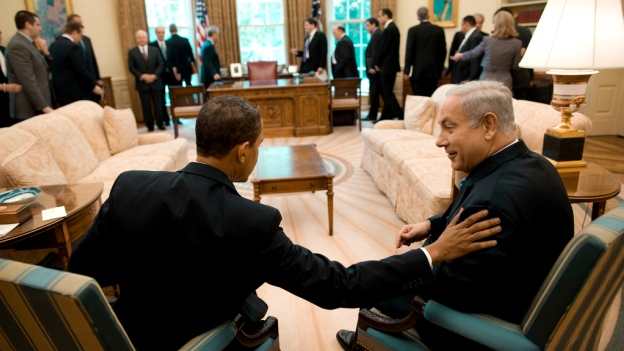
Win Monroe is a research intern at the New America Foundation/American Strategy Program.
The reactions, commentary and analysis of Obama’s meeting with Netanyahu have varied widely in their assessments of Obama’s performance. David Ignatius believes that Obama took a positive first step forward in the peace process, while Martin Indyk went so far as to say that Obama got “suckered,” by Netanyahu.
Of course, the truth is probably less exciting than either analysis suggests. Stephen Walt points out that neither leader had much incentive to clash with the other and that general statements and vague answers to questions reigned the day.
There was some substance, however, to take away from the meeting.
First, Obama made it clear that Israel must honor its commitment to freeze settlement growth if it is to be taken seriously as a partner in the peace process (note: it would have been nice if a reporter could have put this question to Netanyahu in front of Obama, rather than harping on Iran for most of the half hour-long Q&A).
Second, while he did not set a specific deadline, Obama did lay out a rough metric for diplomatic efforts with Iran by identifying the end of the year as a point of assessment.
Third, and probably the only mild surprise, we later learned that Netanyahu and Obama set up a US-Israel working group on Iran, although it is unclear what exactly this amounts to.
Fourth, Obama intends to take a broader regional approach to the peace process, hoping to be able to offer the normalization of relations with moderate Arab regimes as an incentive for Netanyahu to engage his government in the process.
With regards to the last point, in the past many administrations have tried the regional approach and failed – but this does not mean it is a mistake to try again. A sustainable equilibrium is possible only if all of the major regional stakeholders are on board.
This point was emphasized by Zbigniew Brzezinski at a recent national policy forum on US-Saudi Relations hosted by the New America Foundation and the Committee for International Trade. Brzezinski explained that over the last 30 years we have seen clearly that this conflict cannot be resolved by the Israelis and Palestinians alone. He argued that “there is an urgent need for an American – Saudi Arabian genuine alliance for peace in the Middle East.”
David Ignatius seems to think that Obama is heeding Brzezinski’s advice. He describes Obama’s strategy in the following way:
The Obama strategy over the next few months will be to create a regional framework for peace negotiations that’s enticing enough to draw in the wary Netanyahu. To give Israel some quick tangible benefits, the United States wants the Arabs to begin normalizing relations with the Jewish state. Jordan’s King Abdullah describes this promise of recognition by the Arab League nations as a “23-state solution.”
The key to this front-loading strategy is Saudi Arabia. But the Saudis warn privately that they won’t normalize anything unless Israel makes some dramatic moves — such as freezing settlements in the occupied West Bank — that demonstrate its commitment to the 2003 “road map” for peace.
Now the question is whether the United States can provide the leadership and trust necessary for all sides to make the painful concessions necessary to move forward.
— Win Monroe


13 comments on “Guest Post by Win Monroe: Discerning the Substance of the Obama-Netanyahu Meeting”